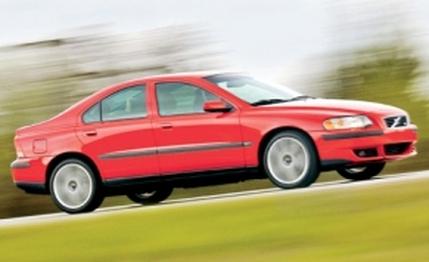
 Road Test
Road Test
Whenever our friends at Volvo stop by the office to lend us their latest and greatest, odds are good we'll hear more about airbags and Boron steel than horsepower and handling. Volvo's first and foremost selling point is that its cars are dedicated to the issue of safety. Like contraceptives, they prevent unplanned things from happening, but they're not much fun. Nonetheless, it's a rep that has kept the Swedish brand afloat through economic dips and competitive tidal waves, although it couldn't prevent the Norwegian car carrier Tricolor from establishing residency at the bottom of the English Channel last December with 350 XC90s aboard. If only those 2100 airbags had deployed.
We were pleasantly surprised, then, when Volvo product communications manager Dan Johnston and R-car line manager Hans Nilsson arrived in our parking lot with a Passion Red 2004 S60R AWD and we heard the word "safe" right before "good-bye."
"Oh, and of course it's really safe," said Johnston as he drove off. That's it? That's all the safety talk we get? Damn, this really is a different kind of Volvo.
According to Nilsson, Volvo forked out 10 times as much money on the S60R compared with any previous R model, the last being the 240-hp 850 T-5R wagon of 1995. That's probably why the S60R features 300 horsepower, all-wheel drive, a fancy adjustable suspension, and Brembo brakes. Volvo must be prepared for diminished returns because the R starts at a blue-light-special price of $37,510-$14,610 less than a rear-drive, 349-hp Mercedes C32 AMG sedan but $4025 more than a front-drive, 247-hp S60 T5 and $4675 above a 208-hp S60 2.5T AWD. Lest you think that's too much premium, consider that our optioned-up, long-term 2001 T5 stickered at $39,275 and a 2002 AWD we reviewed last May came in at $37,800. Our well-equipped tester, with heated seats, an in-dash four-CD changer, and 18-inch alloys, rang up the register at $41,550.
The S60R is powered by a thoroughly modified version of the 208-hp, 2.5-liter turbocharged in-line five that powers the base XC90 and the S60 AWD. "Thoroughly modified" translates to a low-restriction intake, two intercoolers, reground camshafts, reinforced pistons, continuously variable valve timing on both inlet and exhaust sides, and a new cylinder head and exhaust manifold. It also means bye-bye to the low-pressure Mitsubishi turbo and hello to a larger KKK unit that more than doubles peak boost to 14.7 psi. The result is 300 ponies peaking at 5500 rpm and 295 pound-feet of torque from 1950 to 5250 rpm.
Although refined isn't its middle name-remember this 2.5 is a transversely mounted in-line five, an inherently uncivilized layout-the turbocharged engine exhibits minimal turbo lag and revs willingly to its 6500-rpm redline. It feels coarse doing so, as if the engine were grating a big wedge of Parmesan, and the sound is strained and raucous, causing involuntary teeth clenching when shifting at redline. But the results are all smiles.
Zero to 60 mph comes at just 5.5 seconds, which is a full second quicker than the S60 T5, nearly two seconds faster than the S60 AWD, and most notably, only 0.3 and 0.5 second slower, respectively, than the Mercedes C32 AMG and the 340-hp Audi S4. Reaching the quarter-mile marker takes another 8.5 seconds, to 14 flat at 101 mph, trailing the two Germans by 0.4 but dusting the T5 by 0.9 and the AWD by 1.8.
The engine is paired with a new six-speed manual that's a huge improvement over the five-speed gearbox we experienced in the T5, which had a vague, rather sloppy unit unbefitting a so-called sports sedan. Conversely, the six-speed offers short throws, precise action, and narrowed gates, making quick shifts a satisfying snap. At least one editor thought the gates too narrow, forcing him to constantly ponder which gear was engaged. Praise cannot be heaped on the clutch, however, which engages way too high and feels as if it were hiding a coil-over. This is not a car that one jumps into and instantly drives smoothly. The hyper clutch and the turbo boost require some acclimation time, but once mastered, the R presents few difficulties.
Driven on a mix of roads, it is apparent that engineers gave diligent attention to the R's chassis, creating a sports sedan suitable for both highway and hairpin. The suspension features stiffer springs, revised rear geometry, larger anti-roll bars, and a trick, three-way-adjustable shock system developed jointly by Monroe and Öhlins, a Swedish racing-shock supplier. Each shock features one valve for rebound and compression and is instantaneously adjusted based on input from seven accelerometers placed throughout the car. Volvo calls this technology Four-C, or Continuously Controlled Chassis Concept.